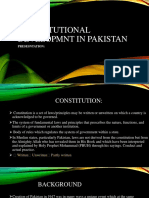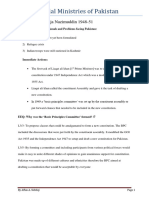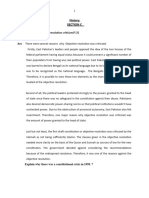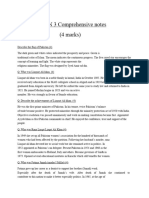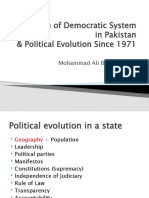CH 9 EXAM 1
CH 9 EXAM 1
Uploaded by
musfirahnaz1701Copyright:
Available Formats
CH 9 EXAM 1
CH 9 EXAM 1
Uploaded by
musfirahnaz1701Copyright
Available Formats
Share this document
Did you find this document useful?
Is this content inappropriate?
Copyright:
Available Formats
CH 9 EXAM 1
CH 9 EXAM 1
Uploaded by
musfirahnaz1701Copyright:
Available Formats
Khwaja Nazimuddin to the Imposition of the First Martial Law
Q: What was the Objectives Resolution? (4)
Ans. The first Constituent Assembly of Pakistan set up a Basic Principles Committee of 25
members to draft the constitution. It presented the Objectives Resolutions on 12th
March 1949. It recommended observance of democracy, freedom, equality, tolerance
and social justice so that Muslims and non-Muslims could follow their faith
comfortably. It also recommended a bicameral parliament. It was sharply criticized by
the Ulama/religious scholars and the East Pakistan. This draft was presented to the
Constituent Assembly on 28th September 1950.
Q: What was the PRODA/Public and Representative Officers
Disqualification Act? (4)
Ans. It was passed by the government of Liaqat Ali Khan and Khwaja Nazimuddin in 1949.
It was aimed at curbing corruption and misuse of power by the politicians and civil
servants. Complaints in this regard could be made to the Governor-General or
Provincial Governors who could order an enquiry by judges. Anyone found guilty
could be debarred from office for a suitable period of time. However, it was seen as a
device that allowed the ruling elite to remove those it did not like. It was repealed in
September 1954 by the Assembly of Malik Ghulam Muhammad.
Q: Describe the constitutional crisis of 1950. (4)
Ans. On 28 September 1950, the draft of the Objectives Resolution was presented before
th
the Constituent Assembly. East Pakistan immediately opposed it as it wanted a share
in the parliament according to the size of its population whereas the Resolution
recommended equal seats of East and West Pakistan. It also opposed imposition of
Urdu as the official language. The provincial politicians opposed the powers of the
head of state and the central government. The Ulama considered the draft
insufficiently Islamic. In November 1950, Liaqat Ali Khan had to withdraw it.
Q: Describe the Liaqat-Nehru Pact/the Minorities Pact. (4)
Ans. It was signed to stop the movement of minorities across the Pak-India border. In April
1950, Pakistani PM Liaqat Ali Khan and Indian PM Jawahar Lal Nehru signed this
agreement. It was agreed that each country would provide protection and religious
freedom to the religious minorities living in Pakistan and India so that these minorities
would be encouraged to stay back in their native state. However, the movement of
people belonging to religious minorities continued to migrate across the border as
they did not trust any such statements made by the government about giving them
protection.
By Dr. Iftikhar-ul-Haq 0333-4257013
Q: What was the Rawalpindi conspiracy case? (4)
Ans. Some army officers were not happy with the government, and they plotted a coup to
overthrow the government. In March 1951, the ‘Rawalpindi Conspiracy Case’ was
discovered by General Ayub Khan and the conspirators were arrested, tried and
imprisoned. They included senior officers like Major-General Akbar Khan and 14 other
officers including the famous poet Faiz Ahmed Faiz. This proved to be a forerunner
of the involvement of army in the politics of Pakistan.
Q: Why was it so difficult to agree on a new Constitution in 1950? (7)
Ans. There were divergent views on the future constitution of Pakistan in 1950. The
Objectives Resolution of March 1949 was the first step towards constitution making.
It was presented to the Basic Principles Committee in September 1950, but majority
opposed the proposals of the Committee. East Pakistan had greater population than
West Pakistan and wanted seats in the bicameral parliament according to the size of
its population. West Pakistan insisted on equal seats for both wings.
East Pakistan also opposed Urdu as the only national language since Bengali
was a developed language and there were no regional languages in East
Pakistan.Bengali was such a rich language that the famous Bengali poet,
Rabindrahnath Tagore, became the first Indian to receive the Nobel Prize in literature.
There were riots against Urdu in East Pakistan till both Urdu and Bengali were
declared the national languages.
Many regional and religious politicians also opposed the proposals. For tire
provincial parties, powers of the President and the central government had to be
reduced in order to guarantee provincial autonomy. Religious parties wanted
enforcement of the Sharia' (Islamic law) and considered the Resolution insufficiently
Islamic. Finally, Liaqat Ali Khan had to withdraw the constitutional proposals and
Pakistan would have to wait another six years to have its own constitution.
Q: Describe the 1954-55 constitutional crisis. (4)
Ans. Governor-General Ghulam Muhammad wanted to retain the executive powers
whereas his PM, Muhammad Ali Bogra opposed him. He was in favour of a purely
parliamentary form of government with the PM as the executive head of state. On 21st
September 1954, Bogra got an important bill passed by the Assembly while Ghulam
Muhammad was abroad. Under the bill, it was binding on the Governor-General to
take the advice of his Ministers. The Assembly also repealed the PRODA (Public and
Representative Officers Disqualification Act). Ghulam Muhammad, acting quickly,
dissolved the Constituent Assembly and dismissed the Bogra government on 29
September 1954.
Source A: Part of a joint statement of Liaqat Ali Khan and Nehru
“With a heavy heart we both have reached a consensus about stopping the movement
of minorities across the Indo-Pak border. We know well this will lead to division of millions of
families. However, this will give an opportunity to both the countries to set examples of
tolerance and generosity towards the respective minorities. We pledge to materialize this
dream.”
By Dr. Iftikhar-ul-Haq 0333-4257013
Q.1 (a) According to source A what message is being delivered by the two
heads of states?
[3]
Ans.
India and Pakistan have agreed to stop the movement of minorities from one to the
other country. Both the Prime Ministers are expressing their sadness over the decision.
They want to set example of kind treatment of minorities.
Source B, a photograph of Liaqat-Nehru Pact signed in New Delhi in 1950.
Q. What does Source B tell us about Pak-India relations in 1950? [5]
Ans.
This is an important meeting the Prime Ministers of Pakistan and India. There are
several delegates of both countries witnessing the signing of the Pact. Liaqat Ali Khan is
wearing the national dress introduced by Jinnah that reflects his strong sense of Pakistani
nationalism whereas Nehru is clad in typical Hindu outfit. Both Prime Ministers have reached
a consensus about stopping the movement of minorities across the border as both are signing
the documents. This Pact would mark a temporary improvement in Pak-India relations as well
as a significant stoppage of minorities across the Indo-Pak border.
By Dr. Iftikhar-ul-Haq 0333-4257013
Sample Question
Source A, part of the declaration of Malik Ghulam Muhammad,
“The Governor-General, having considered the political crisis with which the country is faced,
has decided to declare a state of emergency. The Constituent Assembly, as at present
constituted, has lost the confidence of the people and can no longer function. Until such time
as elections are held, the administration of the country will be carried out by a reconstituted
Cabinet”.
Q: According to source A, how is Malik Ghulam Muhammad
justifying his
act? (3)
Ans. Ghulam Muhammad is referring to the political crisis that necessitated the declaration
of emergency. According to his claim, the Constituent Assembly was rightly dissolved
as it had lost the confidence of the people. He is talking about his plan of holding fresh
elections so that a new assembly could be elected.
Source B,
A Photograph of Malik Ghulam Muhammad inaugurating the Golden
Jublee Session of the Anjuman-e-Taraqqi-e-Urdu in October 1953.
Q: What do we learn about the ambitions of Ghulam Muhammad
regarding the promotion of Urdu? [5]
Ans.
The source shows a very important occasion as the Governor General is surrounded
by some important state officials. The Baba-e-Urdu, Maulvi Abdul Haq is seated very close
to Malik Ghulam Muhammad, that reflects the recognition of his importance in working for
Urdu. Both carry a serene look that reflects their dedication to the promotion of the national
language. All the participants are wearing the national dress of Pakistan, the traditional
‘sherwani’ with pyjamas that conveys a message of Pakistani nationalism. This will be one of
a series of steps taken by various governments of Pakistan to promote national unity by way
of patronizing the national language, Urdu.
By Dr. Iftikhar-ul-Haq 0333-4257013
Q: Describe the 1956 constitution.
[4]
Ans. It was approved by the 2nd Constituent Assembly elected under the rule of Iskander
Mirza. It was a compromise between the Muslim League and the United Front.
Pakistan was officially called Islamic Republic of Pakistan and Mirza became the
President. It empowered the president to choose the PM and dissolve the National
Assembly and the Cabinet under his emergency powers. The President had to be a
Muslim. There were equal seats of East and West Pakistan in the Assembly under
the One Unit Scheme. It was abrogated in October 1958 under the first martial law of
Pakistan.
Q: What was the One Unit Scheme? [5]
Ans. On 14th October 1955, Governor-General Iskander Mirza implemented the One Unit
Scheme. Under this, all provinces of West Pakistan were unified to become a single
province against the single province of East Pakistan. Both East and West Pakistan
were given equal seats in the National Assembly though East Pakistan had 10 million
more people than West Pakistan. Therefore, it was opposed by East Pakistan and the
smaller provinces of West Pakistan. However, it remained valid in the 1956 and the
1962 constitutions. It was scrapped by General Yahya Khan in March 1969.
Q: What was the SEATO/South East Asia Treaty Organization? [4]
Ans. In September 1954 the SEATO was set up to counter the communist/Soviet influence
in the South East Asian states. Its members were the US, the UK, France, the
Philippines, Thailand, New Zealand and Australia. Pakistan joined it in 1955 in the
face of fierce opposition at home. Under the treaty, if any member was attacked by a
communist state, it could seek help from other members. Pakistan tried to persuade
the members to set up a permanent military to protect all members against an attack
by any country but in vain. Thus Pakistan failed to receive any help by the SEATO in
the 1965 and 1971 wars. It left it in 1972.
Q: What was the CENTO/Central Treaty Organization? [4]
Ans. It was a US-sponsored military bloc aimed at countering the communist/Soviet
influence in the Middle East. Initially, Turkey and Iraq had signed the treaty called the
Baghdad Pact in 1955. Pakistan, Iran and the UK joined it the same year. Iraq left it
in 1959 because of a revolution, and the treaty was renamed CENTO. However,
despite regular meetings the group never became a permanent structure with a
combined army. Like the SEATO, it too could not help Pakistan in the 1965 and 1971
wars. It was dissolved in 1979.
By Dr. Iftikhar-ul-Haq 0333-4257013
Q: Who of the following contributed the most to Pakistan’s domestic
policies between 1948 and 1958:
(i) Liaquat Ali Khan
(ii) Malik Ghulam Muhammad;
(iii) Iskander Mirza
Explain with reference to all three above. (14)
Ans. All 3 had their own achievements. Liaqat Ali Khan acted as PM first with Muhammad
Ali Jinnah. Khawaja Nazam ud Din became 2nd Governor General in September, 1948
and Laiqat Ali Khan made some achievements. His major contribution was the
passage of the Objectives Resolution in March 1949. It was a constitutional draft that
outlined the objectives and principles of the future constitution of Pakistan. It was
reviewed by the Basic Principles Committee in September 1950 and the revised draft
recommended a bicameral legislature/parliament with both houses having equal
powers. Urdu was kept as national language and President was to be elected by the
joint session of the parliament. However, the religious parties declared it insufficiently
Islamic. East Pakistan objected to equal share in the parliament as it had 10% more
population than West Pakistan. It also criticized on Urdu being the only national
language because Bengali was also a developed and only language spoken
throughout East Pakistan.
Liaqat Ali Khan managed to keep Pakistan’s economy growing by presenting surplus
budgets. Also, he implemented the PRODA (Public and Representative Officers
Disqualification Act) in order to curtail corruption in Pakistan. However, corruption
would continue to bother future governments.
Liaqat Ali Khan was able to foil a coup of about 20 military officers who were unhappy
over the presence and influence of British officers in the Pakistan Army. In March
1951, in the famous Rawalpindi Conspiracy case, Major Akbar Khan and fourteen
other officers were arrested. However, in October 1951. Liaqat Ali Khan was killed in
Rawalpindi while addressing a public rally.
Malik Ghulam Muhammad became the 3rd Governor General in Oct. 1951. He
persuaded Khawaja Nazam ud Din to step down as Prime Minister enticing him that
he would enjoy more executive powers. Being an expert in financial affairs he
introduced the scheme of 6 Year Plan that was later changed into a 5 Year Plan. Its
aim was to make economic planning regarding agriculture, industry, power and
transport sectors. He set up a Planning Board in 1953 to review various developments
schemes. A major jute processing plant was set up in 1952 in East Pakistan as a
result of efforts for exploring oil and gas reserves, natural gas was discovered at Sui
in Balochistan in 1952.
In 1952-53 Pakistan had positive Balance of Payment (BOP) due to a huge demand
of cotton and jute in the wake of the Korean war that caused large scale export of
these commodities.
During the same period, however, there was serious food shortage due to severe
drought in East and West Pakistan. This caused unrest and violence that was
aggravated by an anti-Qadiani movement. Religious parties demanded removal of
Qadinis /Ahmadis from key posts including the foreign minister Sir Zafar ullah Khan,
Malik Ghulam Muhammad dismissed Khawaja Nazam ud Din in April 1953 on his
failure to control the crisis.
By Dr. Iftikhar-ul-Haq 0333-4257013
Muhammad Ali Bogra, the new PM, worked on constitution making. He was ready to
implement the constitution in December 1954. A clause about restricting the powers
of the Governor General was passed in just 15 minutes in the absence of Malik
Ghulam Muhammad. PRODA was also abolished as G.G could misuse it. When
M.G.Muhammad came to know about this he quickly acted and dismissed Bogra’s
government and dissolved the Constituent Assembly in September 1954. The new
Constituent Assembly was elected in June 1955. In August 1955 M.G. Muhammad
fell ill and Iskandar Mirza became the new Governor General.
Mizra, a retired military general, took bold steps. First he dismissed Bogra and
appointed Ch. Muhammad Ali as new P.M. Ch. M. Ali drafted Pakistan’s first
Constitution that was implemented in March 1956. It introduced federal, parliamentary
form of government though the President had powers to appoint and dismiss the P.M.
Under the One Unit Scheme, East and West Pakistan had equal seats in the one
house parliament, the National Assembly. However, the Constitution was abrogated
in Oct.,1958 by Mirza himself.
The One Unit Scheme, introduced in Oct.,1955 was aimed at unity by merging
together all provinces of West Pakistan to make two provinces East and West
Pakistan. It, however was bitterly opposed by E. Pakistan and smaller provinces of
W. Pakistan
Mirza also started some industrialization and development plans as well as rural
development schemes. Karachi airport was completed, railways were modernized
and telephone network was expanded. Steps were taken for provision of health and
education.
Mirza failed to have good relations with his Prime Ministers and dismissed them at
short intervals. Ch. M. Ali was replaced by Hussain Shaheed Suharwardy in
Sept.,1956. Suharwardy was replaced by I.I. Chundrigar in Oct.,1957 who himself
was dismissed in Dec.,1957. Malik Feroze Khan Noon was the last civilian P.M. under
Mirza from Dec.,1957 to 7th October, 1958. Finally, on 7th Oct., 1958 he declared
Martial Law and appointed General Ayub Khan as the CMLA (Chief Marital Law
Administrator).
In conclusion, Liaqat Ali Khan seems to be the most successful as he took first step
towards political and economic stability of Pakistan. The Objectives Resolution of
March 1949 remains the preamble of the 1973 Constitution till today.
By Dr. Iftikhar-ul-Haq 0333-4257013
Q: Why were there so many governments between 1951 and 1958? (7)
Ans. Pakistan did not have a good team of skilled politicians. Jinnah died in 1948 without
accomplishing his mission of providing a strong political base to Pakistan. Murder of
Liaqat Ali Khan in 1951 worsened the political conditions as the newly created state
of Pakistan lost the two most experienced leaders and the country went in the hands
of inexperienced and selfish politicians like Malik Ghulam Muhammad and Iskander
Mirza. Due to their flawed policies, there was political instability and uncertainty
between 1951 and 1958. Several prime ministers were dismissed and the first
Constituent Assembly was dissolved by Malik Ghulam Muhammad in September
1954.
The Indian government was bent upon creating difficulties for Pakistan. It continued
to delay the release of Pakistan’s share of assets and announce the accession of the
State of Kashmir to Pakistan. It imposed a war on Pakistan in 1948 as a result of
which Pakistan was forced to pay more attention on its defence instead of building a
strong political foundation. The Indian PM Mr Nehru never fulfilled the promise of
holding a plebiscite in Kashmir in the 1950s which led to failed relations between the
two states. India closed the two headworks in the Indian Punjab that supplied water
to Pakistan and this added to the problems of Pakistan throughout the 1950s.
East Pakistan wanted a share in the government according to its population size that
was 10% greater than that of West Pakistan but it was given equal seats in the
National Assembly under the undemocratic One Unit Scheme and the rule of parity.
West Pakistan dominated the political affairs with Karachi as the capital and the
headquarters of the armed forces located in its territory. Declaring Urdu as the
national language further alienated East Pakistan, and the geographical distance
between the two wings of Pakistan gradually became a political gulf.
Q: Why did Ayub Khan come to power in 1958? / Why was martial
law imposed in Pakistan in 1958? (7)
Ans. Political instability worsened between 1955 and 1958 as several Prime Ministers were
dismissed in this period. Differences between West and East Pakistan grew as the
latter wanted a share in the government according to its population size that was 10%
greater than that of West Pakistan but it was given equal seats in the National
Assembly under the undemocratic One Unit Scheme and the rule of parity. West
Pakistan’s dominance over the political affairs was strongly resented by East Pakistan
as it was already backward economically.
The 1956 Constitution empowered the President to nominate and dismiss the Prime
Minister. President Iskander Mirza terminated as many as four governments between
1955 and 1958 as a result of which he began to lose popularity and power. PM
Hussain Shaheed Suharwardy gave very tough time to Mirza by uniting the major
political leaders of Punjab and Bengal against him. He challenged Mirza to hold a vote
in the Assembly to test his popularity. Mirza feared a defeat and, therefore, decided
to declare martial law on 7th October 1958 and appointed General Ayub Khan as the
CMLA (Chief Martial Law Administrator).
Ayub was appointed Prime Minister by Mirza on 24th October 1958. Ayub had already
declined an offer from Ghulam Muhammad to take over the country as its executive
head. Now he could see the nominal powers of Mirza who was holding his post
forcefully. Therefore, Ayub decided to assume power himself. He removed Mirza from
office and himself became the executive head of state on 27th October 1958.
By Dr. Iftikhar-ul-Haq 0333-4257013
You might also like
- HISTORY OF PAKISTAN FOR O LEVELS Section 3 NotesDocument26 pagesHISTORY OF PAKISTAN FOR O LEVELS Section 3 Notesbesties tube94% (17)
- Lahore Resolution 1940Document24 pagesLahore Resolution 1940KhanpurKing171% (7)
- Pakistan Affairs Post PartitionDocument27 pagesPakistan Affairs Post PartitionAbdul Hadi QureshiNo ratings yet
- Causes of Delay in Constitution Making of PakistanDocument6 pagesCauses of Delay in Constitution Making of PakistanHamza Shahid100% (5)
- History LAK ^0 KNDocument4 pagesHistory LAK ^0 KNHASSAN IRFANNo ratings yet
- Topic 19Document10 pagesTopic 19hannan arif100% (1)
- Iskander Mirza (Auto-Saved)Document14 pagesIskander Mirza (Auto-Saved)ahraaraamirNo ratings yet
- Topic 26 Final.1947-56Document9 pagesTopic 26 Final.1947-56Ayesha ShahzadNo ratings yet
- Wa0027.Document48 pagesWa0027.hadia bilalNo ratings yet
- HIST TOPIC 25 Early Years 1947 To 1958 PDFDocument3 pagesHIST TOPIC 25 Early Years 1947 To 1958 PDFabubakar100% (1)
- PAK301 Mcqs MergedDocument361 pagesPAK301 Mcqs Mergedbavoca8322No ratings yet
- CONSTITUTIONAL DEVELOPMNT IN PAKISTAN NewDocument12 pagesCONSTITUTIONAL DEVELOPMNT IN PAKISTAN NewNaziyaa PirzadaNo ratings yet
- Constitutional Developmnt in Pakistan NewDocument12 pagesConstitutional Developmnt in Pakistan NewNaziyaa PirzadaNo ratings yet
- History OI Pakistan Nationhood 1949-58 NotesDocument3 pagesHistory OI Pakistan Nationhood 1949-58 NotesTeenage GirlNo ratings yet
- Initial MinistriesDocument17 pagesInitial MinistriesAhmed shehzad KhanNo ratings yet
- Constitutional Development During 1947 To 1958Document4 pagesConstitutional Development During 1947 To 1958Abdul MajidNo ratings yet
- Pakistan During Khuwaja Nazim Uddin and Liaquat AliDocument93 pagesPakistan During Khuwaja Nazim Uddin and Liaquat Alirussia russiaNo ratings yet
- Constitution 1956 FinalDocument19 pagesConstitution 1956 Finalmuhammad qureshi100% (1)
- Govts 1951-58Document4 pagesGovts 1951-58zoraizahmed991No ratings yet
- Constitutional Development in Pakistan-1Document13 pagesConstitutional Development in Pakistan-1IramNo ratings yet
- Assigment No 2Document10 pagesAssigment No 2Johar marwatNo ratings yet
- History Section 3 Notes PDFDocument24 pagesHistory Section 3 Notes PDFMa Dong ChanNo ratings yet
- Chapter 12Document60 pagesChapter 12strikereureka879No ratings yet
- HIST TOPIC 25 Early Years 1947 To 1958 PDFDocument3 pagesHIST TOPIC 25 Early Years 1947 To 1958 PDFThe Javi ArmyNo ratings yet
- Iskander Mirza PresentationDocument21 pagesIskander Mirza PresentationMxchloeNo ratings yet
- Lecture 3Document7 pagesLecture 3MH SakibNo ratings yet
- Salient Features of 1956, 1962, 1973 ConstitutionDocument10 pagesSalient Features of 1956, 1962, 1973 ConstitutionSaad Khan100% (1)
- Lecture 18Document2 pagesLecture 18bc240222880musNo ratings yet
- History Notes Chapters 12 and 13Document15 pagesHistory Notes Chapters 12 and 13Saima SyedNo ratings yet
- Iskander Mirza PresentationDocument21 pagesIskander Mirza PresentationGamer Scorpio2255No ratings yet
- Mid 2 MaterialDocument126 pagesMid 2 MaterialKaran malhiNo ratings yet
- Topic: Debates in The 1 Constitution AssemblyDocument10 pagesTopic: Debates in The 1 Constitution AssemblytufailNo ratings yet
- Lecture No. 10, Objective Resolution and ConstituitionsDocument24 pagesLecture No. 10, Objective Resolution and ConstituitionsMoiz SiddiquiNo ratings yet
- Constitutional Development of Pakistan-2Document19 pagesConstitutional Development of Pakistan-2Basharat Aslam100% (1)
- History of East Pakistan - WikipediaDocument11 pagesHistory of East Pakistan - WikipediazubaerjewelNo ratings yet
- 21-KB Saeed, Democracy PDFDocument19 pages21-KB Saeed, Democracy PDFJohar Nawaz100% (1)
- Political and Constitutional Development of Pakistan 1947-1958Document17 pagesPolitical and Constitutional Development of Pakistan 1947-1958Owais AliNo ratings yet
- History Section 3 NotesDocument36 pagesHistory Section 3 Notesmalaika StudentNo ratings yet
- Constitutional Development in PakistanDocument11 pagesConstitutional Development in Pakistanalexacrystallin100% (2)
- Liaquat Ali KhanDocument2 pagesLiaquat Ali KhanHashir UsmanNo ratings yet
- Government and Politics in Pakistan 1947 To 2019Document5 pagesGovernment and Politics in Pakistan 1947 To 2019Zahraa Mahrukh100% (1)
- Sir Baba Khail 01Document60 pagesSir Baba Khail 01me Mn khanNo ratings yet
- Pakistan Legal System Constitutional HisDocument16 pagesPakistan Legal System Constitutional HisAkif RajpootNo ratings yet
- PST Notes (1947 - 88)Document32 pagesPST Notes (1947 - 88)Syed Saad AliNo ratings yet
- Constitution CrisisDocument5 pagesConstitution CrisispinkiepieNo ratings yet
- Shahroz Pakstudies AssignmentDocument12 pagesShahroz Pakstudies AssignmentAyaanJawwadNo ratings yet
- Sir Baba Khail 01Document40 pagesSir Baba Khail 01Rabia JavedNo ratings yet
- Early Ministries Notes CompiledDocument7 pagesEarly Ministries Notes CompiledMuhammad Qasim HassanNo ratings yet
- The Constitution Making in Pakistan 1956 PDFDocument7 pagesThe Constitution Making in Pakistan 1956 PDFsyeduop3510No ratings yet
- constitution delayDocument6 pagesconstitution delaynobodycaresrightyouknowNo ratings yet
- Political History of PakistanDocument48 pagesPolitical History of PakistanNoor e IlmNo ratings yet
- Analytical Report Writing DocumentDocument13 pagesAnalytical Report Writing DocumentTechnical saadNo ratings yet
- The Constitution of Pakistan 1956Document5 pagesThe Constitution of Pakistan 1956areebaahmad2005No ratings yet
- COSC201101052Document18 pagesCOSC201101052Shukran MaryamNo ratings yet
- Constitutional Development of Islamic Republic of Pakistan Till 1973 1000 Word EssayDocument7 pagesConstitutional Development of Islamic Republic of Pakistan Till 1973 1000 Word Essayapi-2647335300% (1)
- Topic 26 Final.1947-56Document5 pagesTopic 26 Final.1947-56Nawab ILyasNo ratings yet
- Pakistan From 1947-58Document19 pagesPakistan From 1947-58Shukran MaryamNo ratings yet
- Sir Baba Khail 01Document60 pagesSir Baba Khail 01Zainab HaiderNo ratings yet
- Lahore Resolution 1940Document24 pagesLahore Resolution 1940khalidsana603No ratings yet
- Lecture Notes Constitutional and Politcal Development 1945 To 56Document12 pagesLecture Notes Constitutional and Politcal Development 1945 To 56azharNo ratings yet
- Causes of Delay in Constitution Making of PakistanDocument6 pagesCauses of Delay in Constitution Making of PakistanHamza ShahidNo ratings yet
- Basic Principle Committee Interim Report 1950Document27 pagesBasic Principle Committee Interim Report 1950Irfan KhanNo ratings yet
- 4668-1 SadiaDocument22 pages4668-1 SadiaNabeel zafarNo ratings yet
- HUM111 Slides Lecture15Document29 pagesHUM111 Slides Lecture15baseer khanNo ratings yet
- Reasons For Delay in The Constitution Making of PakistanDocument3 pagesReasons For Delay in The Constitution Making of PakistanSajeel AhmedNo ratings yet
- Political History of PakistanDocument48 pagesPolitical History of PakistanNoor e IlmNo ratings yet
- Constitution of Pakistan - 1956 - English by EmazDocument2 pagesConstitution of Pakistan - 1956 - English by Emazemaz kareem StudentNo ratings yet
- PAK301 Lecture Wise (Short Questions File For Final Exams Preperation)Document24 pagesPAK301 Lecture Wise (Short Questions File For Final Exams Preperation)fahdimughal63100% (1)
- Pak Affairs Lec 1Document7 pagesPak Affairs Lec 1hizbanaz22No ratings yet
- The First Constituent Assembly of PakistanDocument10 pagesThe First Constituent Assembly of Pakistanmuhi51747No ratings yet
- Constitutional Developments in PakDocument27 pagesConstitutional Developments in PakAsad LatifNo ratings yet
- Early Ministries Q & ADocument4 pagesEarly Ministries Q & Asyed meesumNo ratings yet
- Section 3 Notes by Sir Fahad PDFDocument24 pagesSection 3 Notes by Sir Fahad PDFKhalida AsgharNo ratings yet
- Solved Mcqs of Pak301: Arslan AhmedDocument7 pagesSolved Mcqs of Pak301: Arslan AhmedMuhammad AtharNo ratings yet
- Constitutional Developments in PakistanDocument16 pagesConstitutional Developments in PakistanOmer NaseerNo ratings yet
- Constitutional Development of Pakistan Since 1947 To The PresentDocument31 pagesConstitutional Development of Pakistan Since 1947 To The Presentmaqbool ur rehmanNo ratings yet
- Early Ministries 1948 To 1958 Notes by Sir Walid FularaDocument17 pagesEarly Ministries 1948 To 1958 Notes by Sir Walid Fularahayah50emadNo ratings yet
- Chapter 12Document18 pagesChapter 12Abid Natha'm iNo ratings yet
- PAK301-MCQs Solved+midtermrDocument10 pagesPAK301-MCQs Solved+midtermrAijaz khanNo ratings yet
- Constitutional Development of Pakistan (1947-56) Dr. Khalid Manzoor ButtDocument12 pagesConstitutional Development of Pakistan (1947-56) Dr. Khalid Manzoor ButtUmairNo ratings yet
- Causes For Delay in The Constitution MakingDocument2 pagesCauses For Delay in The Constitution Makingmalik54315No ratings yet
- Early Ministries Notes CompiledDocument7 pagesEarly Ministries Notes CompiledMuhammad Qasim HassanNo ratings yet
- Basic Principles Committee - WikipediaDocument23 pagesBasic Principles Committee - WikipediaSafi UllahNo ratings yet
- Pak 301 Grand Quiz McqsDocument19 pagesPak 301 Grand Quiz McqsHamza Ali SoomroNo ratings yet
- First Constituent Assembly of PakistanDocument4 pagesFirst Constituent Assembly of Pakistansidra khanNo ratings yet
- Efforts For The Establishment of Islamic System in PakistanDocument14 pagesEfforts For The Establishment of Islamic System in PakistanAfrasiyab RipplerNo ratings yet
- Wa0028.Document26 pagesWa0028.hadia bilalNo ratings yet
- Solved MCQ of Pak101Document6 pagesSolved MCQ of Pak101RAYYAN ZAFARNo ratings yet












